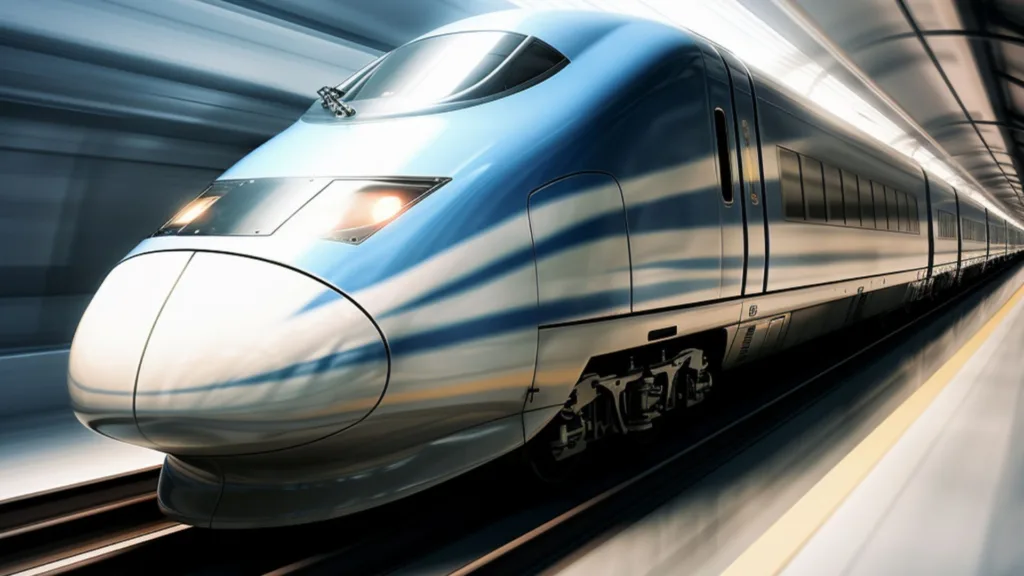India’s railway network, one of the largest and busiest in the world, is undergoing a transformation with the introduction of the Vande Bharat Express trains. These trains represent a significant leap forward in terms of speed, comfort, and technology, symbolizing India’s strides towards modernizing its transportation infrastructure. In this blog, we’ll explore the features, significance, and impact of Vande Bharat trains on the Indian railway system.

Table of Contents
ToggleHow did Vande Bharat Express come into existence?
The Vande Bharat Express, also known as Train 18, is an indigenously designed and manufactured semi-high-speed train. The project was spearheaded by the Integral Coach Factory (ICF) in Chennai under the ‘Make in India’ initiative. The first Vande Bharat Express was flagged off by Prime Minister Narendra Modi on February 15, 2019, from New Delhi to Varanasi. Since then, routes such as the vande bharat mumbai to goa, vande bharat delhi to varanasi, and vande bharat chennai to coimbatore have been added.
Key Features of Vande Bharat Trains
Vande Bharat Express trains are equipped with a plethora of modern features designed to enhance passenger comfort and safety. Here are some of the standout features:
- High-Speed Capabilities: Capable of reaching speeds up to 180 km/h, these trains significantly reduce travel time between major cities. For instance, the vande bharat mumbai to ahmedabad route offers a faster alternative to conventional trains.
- Aerodynamic Design: The train’s sleek, aerodynamic design reduces air resistance, contributing to its high-speed performance and energy efficiency.
- Comfortable Seating: The trains offer reclining seats, ample legroom, and generous luggage space. The Executive Class boasts even more luxurious seating with increased
Vande Bharat Train Routes and Ticket Pricing
As the Vande Bharat Express continues to expand, more routes are being added to the network. Some of the new and existing routes include:
- New Delhi to Varanasi: This was the inaugural route for the Vande Bharat Express, covering the distance in just over 8 hours.
- Mumbai to Ahmedabad: This route has significantly reduced travel time between these two major cities, catering to business travelers and tourists alike.
- Mumbai to Goa: The Vande Bharat Express Mumbai to Goa route is a favorite among holidaymakers, offering a faster and more comfortable journey.
- Bangalore to Chennai: The Vande Bharat Express Bangalore to Chennai route connects two major tech hubs, promoting business and leisure travel.
- Delhi to Katra: Serving pilgrims traveling to the Vaishno Devi shrine, this route is one of the busiest.
The Vande Bharat Express ticket price varies depending on the route and class of travel. For example, ticket prices for the Mumbai to Goa route are higher compared to traditional trains, but passengers are willing to pay for the reduced travel time and enhanced comfort. Booking tickets is also straightforward, with options available both online and at railway stations.
Vande Bharat Express: Interior and Amenities
The Vande Bharat Express train interior is designed to offer a premium travel experience. Key features include:
- Reclining Seats: Both the Chair Car and Executive Class have ergonomically designed seats that recline for added comfort.
- Large Windows: Panoramic windows offer excellent views, making the journey more enjoyable.
- Modern Toilets: The Vande Bharat Express toilet facilities are bio-vacuum and eco-friendly, ensuring hygiene and sustainability.
- Onboard Catering: The train offers high-quality food and beverage services, enhancing the overall travel experience.
- Entertainment Systems: Passengers can enjoy onboard Wi-Fi and entertainment systems, making the journey more pleasant.
Booking and Accessibility
Booking a Vande Bharat train ticket is user-friendly, with several options available:
- Online Booking: Tickets can be booked through the official IRCTC website and app. The process is simple and convenient.
- Station Booking: Tickets can also be purchased at railway station counters.
- Travel Agents: Authorized travel agents provide ticket booking services for those who prefer a more personalized experience.
For those traveling on routes like Vande Bharat Express Howrah to Puri or Vande Bharat Express Bangalore to Hyderabad, it’s advisable to book tickets in advance due to high demand.
Future Expansion Plans
The future of Vande Bharat trains looks promising, with several new routes and services planned:
- Howrah to Puri: The Howrah Puri Vande Bharat Express will enhance connectivity in the eastern region.
- Patna to Ranchi: The Vande Bharat Express Patna to Ranchi route will improve access between Bihar and Jharkhand.
- Delhi to Jaipur: A route from Delhi to Jaipur is expected to boost tourism and business travel.
- Mumbai to Shirdi: The Vande Bharat Mumbai to Shirdi route will cater to pilgrims visiting the famous Shirdi Sai Baba temple.
In addition to expanding the network, Indian Railways is focused on enhancing the technology and efficiency of these trains. This includes:
- Speed Enhancements: Efforts are being made to increase the operational speed of the trains to 200 km/h, further reducing travel times.
- Green Initiatives: Continued focus on energy efficiency and environmental sustainability is a priority.
- Global Collaboration: Potential collaborations with global train manufacturers to bring in advanced technologies and best practices.
Conclusion
The Vande Bharat Express trains are revolutionizing rail travel in India, offering a blend of speed, comfort, and modern amenities. These trains not only enhance the travel experience for passengers but also signify a significant leap in India’s transportation infrastructure. With ongoing expansion plans, technological advancements, and a commitment to sustainability, the future of Vande Bharat trains is bright.
As India continues to innovate and expand its Vande Bharat fleet, passengers can look forward to a new era of rail travel that is faster, safer, and more comfortable. The Vande Bharat Express is not just a mode of transport; it is a symbol of India’s progress and ambition, setting new benchmarks for rail travel globally. Whether you are a frequent traveler or planning your next trip, the Vande Bharat Express promises a journey like no other.
Frequently Asked Questions
Q: What’s the route of Vande Bharat Express?
A: Some of the prominent routes include
• New Delhi to Varanasi via Kanpur and Prayagraj
• New Delhi to Katra( Jammu)
• Mumbai to Gandhinagar via Ahmedabad
• Chennai to Mysuru via Bengaluru
• Howrah to New Jalpaiguri
Each route is designed to reduce trip time significantly compared to conventional trains.
Q: How numerous Vande Bharat Express trains are there in India?
A: As of now, there are multiple Vande Bharat Express trains functional in India, with plans for further in the future. The exact number can vary as new routes are introduced. presently, there are around 10- 15 Vande Bharat Express trains running across different routes in the country.
Q: What’s the cost of a ticket in Vande Bharat Express?
A: The ticket prices for Vande Bharat Express vary depending on the route, class( Administrative president Auto or Chair Car), and the trip’s distance.
Q: Is food free in Vande Bharat?
A: Yes, food is generally included in the ticket price for Vande Bharat Express. The type and quality of food can vary grounded on the class of trip and the duration of the trip. Passengers can anticipate a variety of refection, including breakfast, lunch, snacks, and regale, depending on the time of trip.
Q: Is the Vande Bharat train always on time?
A: The Vande Bharat Express is known for its promptitude and trustability. still, like any other train, it can occasionally face detainments due to colorful reasons similar as track conservation, rainfall conditions, or other unlooked-for circumstances. Overall, it maintains a high position of on- time performance.
Q: How fast is the Vande Bharat train?
A: The Vande Bharat Express is one of the fastest trains in India, with a top speed of 180 km/ h( 112 mph). still, it generally operates at pets of over to 160 km/ h( 99 mph) during regular service, making it significantly briskly than conventional trains on the same routes.







